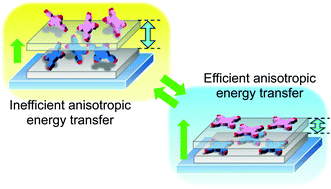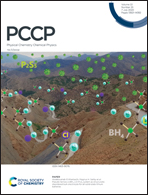Anisotropic energy transfer in a clay–porphyrin layered system with environment-responsiveness†
Abstract
The adsorption orientation behavior of tetrakis(1-methylpyridinium-3-yl)porphyrin (m-TMPyP) and tetrakis(1-methylpyridinium-4-yl)porphyrin (p-TMPyP) on the clay monolayer prepared by the Langmuir Blodgett (LB) technique was investigated using the absorption and dichroic spectra obtained on a waveguide. It was revealed that the orientation of m-TMPyP and p-TMPyP on the clay monolayer, that is parallel and tilted with respect to the clay surface, depends on the surrounding environments such as water and N,N-dimethylformamide (DMF). The anisotropic photochemical energy transfer between m-TMPyP as a donor and p-TMPyP as an acceptor in the layered system was investigated in water and in DMF–water (9/1 (v/v)) by a fluorescence observation. As a result, while energy transfer efficiency (ηET) was 60% for the parallel–parallel orientation in water, that was 10% for the tilted–tilted orientation in DMF–water (9/1 (v/v)). The major factor for the change of ηET could be a change of the distance between m-TMPyP and p-TMPyP, and the J value that is a parameter for spectral overlap between energy donor's fluorescence and acceptor's absorption.



 Please wait while we load your content...
Please wait while we load your content...